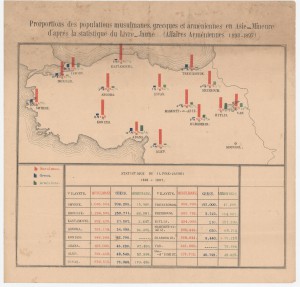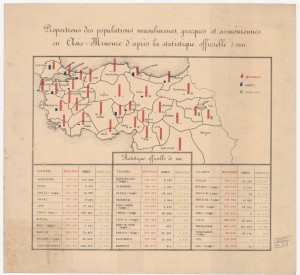The Population of the Armenian Community According to the 1914 Population Statistics
The booklet called the “Ottoman Country’s Population Statistics of 1330” was published in 1336 (1920) after being prepared by the Internal Affairs Ministry Administration of Population Registry. The census was carried out in 1321 (1905) and the population calculated after the census depended on the registry system.
The 1905 census is the last of the censuses that the Ottoman Empire started in the 19th century (Sakin, 2011, p. 189-194). The regulations of the census which started after a long preparation period, and were carried out in a disciplined way (DH. MKT, dossier 971), were prepared 3 years in advance (Karpat, 2003, p. 75). It was purposed to make up for the insufficiencies determined in the former censuses (DH. MKT. 2418/30). The system founded at the end of the census made up the foundation for the registry system used until today (Behar, 1996, p. XVIII).
An important difference of the 1905 census from former censuses is that it made up the foundation of a system which enables a follow-up after the census. According to the regulations, it was required during the census to arrange a statistics scale which shows the male and female populations of neighbourhoods/villages in the counties. One copy of these scales would be sent to the Internal Affairs Ministry via the governorships after being stamped by the personal stamps of the members of the county assembly and these would be recorded in the main books in the Administration of Population Registry (Istatistik, p. 2).
The system founded after the census required that the population offices in the counties prepared a scale which shows the deaths, births, new registers, and transfers happening in the county regularly (every three months) and sent these to Istanbul via the population administrations of the provinces. This information was able to be regularly recorded in the main books where the results of the 1905 census were registered in Istanbul and therefore, a statistics showing the population of the country was able to be created at the end of every year (Istatistik, p. 2). In brief, the statistics which makes the source for the 1905 census data are the results which the population statistics experts obtained in 1330 (1914) after the census and recordings of 1905, and events such as the deaths, births, and transfers were recorded.
The statistics, as we mentioned above, were published in 1920. This date corresponds to a period when Istanbul was under the occupation of Allied Forces and the Ottoman administration and offices were under control. Therefore, it would not be wrong to think that such a controversial issue would not remain outside the knowledge and control of the occupying forces. This situation holds a characteristic which would not give place for objections to the reliability of the statistics.
The Total Population of the Empire in 1914
The Total Amount of Population and Its Distribution According to Ethnic Groups
The statistics were arranged in a way to cover the regions of Anatolia, Rumelia, and Syria in the Ottoman Empire and according to the administrative structure of the year 1914. As census and registration were not done in the provinces Hejaz, Yemen, Musul, Baghdad and Basra, and the sandjaks Lebanon, Asit, and Medina, these provinces and sandjaks were not included in the statistics. Also, the nomad tribes in the eastern provinces and the Kurds in the mountains of the region, and some Nesturis living in tribes within the Hakkari Sandjak, were not counted or registered; and therefore, they were left outside of the statistics regularly done every year (Istatistik, p. 2).
According to the calculations, the total population of ethnic/religious groups living in the mentioned Ottoman provinces and sandjaks are as follows:
| İslam | 15.044.846 | Greek | 1.729.738 |
| Armenian | 1.161.169 | Jewish | 187.073 |
| Greek Catholic | 62.468 | Armenian Catholic | 67.838 |
| Protestant | 65.844 | Latin | 24.845 |
| Assyrian | 54.850 | Ancient Assyrian | 4.133 |
| Keldani | 13.211 | Yakubi | 6.932 |
| Marunî | 47.406 | Samiri | 164 |
| Nesturi | 8.091 | Yazidi | 6.957 |
| Copt | 11.169 | Dürzî | 9.385 |
| Kazakh | 1.006 | Bulgarian | 14.908 |
| Serbian | 1 | Ulah | 82 |
| Total: 18.520.016 | |||
Population Left out of Registry
It is seen that the population left out of census was mostly in the provinces of Van (Van, Hakkari), Bitlis (Bitlis, Muş, Siirt, Bingöl), Diyarbakır (Diyarbakır, Mardin, Siverek, Maden), and Mamuratülaziz (Elazığ, Malatya, Tunceli). The population having this situation is estimated as follows:
| Muslims | |
| Van | 122.370 |
| Bitlis | 922.999 |
| Elazığ | 107.644 |
| Diyarbakır | 196.840 |
| Nesturis | |
| Van | 33.999 |
| Other | |
| Van | 2.122 |
The Distribution of the Armenian Population According to Provinces and Sandjaks
It is seen that Armenian who always migrated from their ancient settlements throughout history were living distributed to almost all places of Anatolia, Rumelia, Syria, and Palestine where the Empire carried out censuses and registries at the beginning of the 20th century. In these regions, the Ottoman Empire was divided into 36 main administration units in 1914. 18 of these were provinces under the administration of governors and the remaining 18 were sandjaks directly administered by the central government. Administrative units of both the statuses are given below in an alphabetical list:
| Province/Sandjak | Gregorian population | |
| 1 | Adana province | 50.139 |
| 2 | Ankara province | 44.507 |
| 3 | Antalya sandjak | 630 |
| 4 | Aydın province | 19.395 |
| 5 | Beyrut province | 1.188 |
| 6 | Bitlis province | 114.704 |
| 7 | Bolu sandjak | 2.961 |
| 8 | Canik sandjak | 27.058 |
| 9 | Çatalca sandjak | 842 |
| 10 | Diyarbekir province | 55.890 |
| 11 | Edirne province | 19.725 |
| 12 | Erzurum province | 125.657 |
| 13 | Eskişehir sandjak | 8.276 |
| 14 | Halep province | 35.104 |
| 15 | Hüdavendigar province | 58.921 |
| 16 | İçel sandjak | 341 |
| 17 | İstanbul province | 72.962 |
| 18 | İzmit sandjak | 55.403 |
| 19 | Kala-i Sultaniye sandjak | 2.474 |
| 20 | Afyonkarahisar sandjak | 7.437 |
| 21 | Karasi sandjak | 8.544 |
| 22 | Kastamonu province | 8.959 |
| 23 | Kayseri sandjak | 48.659 |
| 24 | Konya province | 12.971 |
| 25 | Kudüs sandjak | 1.310 |
| 26 | Kütahya sandjak | 3.910 |
| 27 | Mamuratülaziz province | 76.070 |
| 28 | Maraş sandjak | 27.842 |
| 29 | Menteşe sandjak | 12 |
| 30 | Niğde sandjak | 4.890 |
| 31 | Sivas province | 143.406 |
| 32 | Suriye province | 413 |
| 33 | Trabzon province | 37.549 |
| 34 | Urfa sandjak | 15.161 |
| 35 | Van province | 67.792 |
| 36 | Zor sandjak | 67 |
The system of census and registry, which we can call modern, happened in the 20th century in the Ottoman Empire. This registry system in 1905 makes up the foundation for the population registry system which has existed till today.
The 1905 census was carried out in Rumelian, Anatolian, and Syrian lands of the Ottoman Empire. These regions were divided into 36 main units, 18 of which were provinces, and the other 18 were sandjaks.
Thanks to the system established after the census, regular data was coming to the center from the counties and provinces. Through this data, the population of the Empire was being updated and statistics were made, and thus, the changing population structure was being followed by the center. One of these statistics was prepared for the year 1914. According to the mentioned statistical data, the total population of the Empire in the places of the census was 18,520,016. This was made up of 15,044,846 Muslims and 1,161,169 Gregorian Armenians.
Bibliography
Başbakanlık Osmanlı Arşivi, Dahiliye Nezareti Mektubi Kalemi (DH.MKT), Dossier No: 2418/30, 971, 971-1.
Behar, Cem (1996), Osmanlı İmparatorluğu’nun ve Türkiye’nin Nüfusu 1500-1927, Ankara.
Karpat, Kemal (2003), Osmanlı İmparatorluğu’nun Nüfusu (1830-1914), Demografik ve Sosyal Özellikleri, Istanbul.
Memâlik-i Osmâniyye’nin 1330 Senesi Nüfûs İstatistiki, Dâhiliye Nezâreti Sicil-i Nüfûs İdâre-i Umûmiyyesi, Dersa’adet 1336.
Sakin, Orhan (2011), Osmanlı’da Etnik Yapı ve 1914 Nüfusu, Istanbul.
Categories
- Experience of Living Together of Turks and Armenians
- Demographic Structure of Armenians in the Ottoman Lands
- Disturbances in Anatolia: Protests and Anarchy
- Armenians and the International System: Seeking a Solution
- Historiography in Turkish-Armenian Relations
- Dispatchment and Settlement: Discourses of Genocide
- Trials and International Law
- Armenians in Society and Bureaucracy
- Armenian Diaspora
- Church, Identity, and Social Structure


